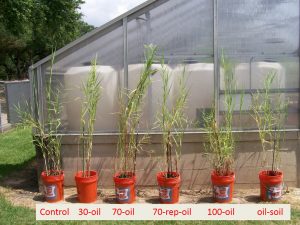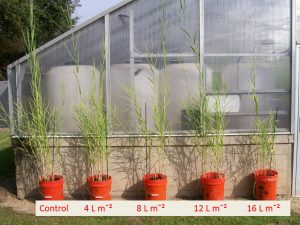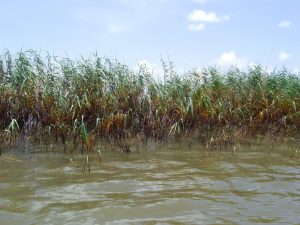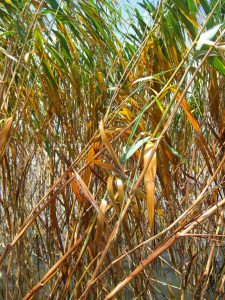Study Reveals Mix of Resilience and Vulnerability of Oiled Marsh Grass
– December 16, 2014
Louisiana State University scientists simulated Deepwater Horizon oiling scenarios with a dominant Mississippi River Delta marsh reed and analyzed its reaction to oil exposure.
They found that Phragmites australis, the common reed, had a high tolerance to above-ground oiling but not to below-ground oiling, which reduced the reed’s growth and function. They published their findings in the February 2014 issue of the Marine Pollution Bulletin: Impacts of Macondo oil from Deepwater Horizon spill on the growth response of the common reed Phragmites australis: A mesocosm study.
The 2010 Deepwater Horizon oil spill caused moderate to heavy oiling of about 304 kilometers of Louisiana marsh, including a large area dominated by P. australis. This wetland grass is especially valuable for Louisiana marshes because of its ability to accumulate and stabilize sediments and adapt to various environmental conditions. With many factors influencing oil impact and habitat recovery, wetland scientists can reduce uncertainty by systemically investigating factors in both controlled greenhouse and laboratory settings, as well as in semi-controlled field studies.
This study’s team used a hybrid approach of exposing marsh sods (sections of the natural marsh with natural plant populations and associated soil and microbial conditions) to various scenarios of oil exposure under controlled greenhouse conditions. By doing so, they could limit the effects of extraneous environmental factors on marsh response, yet still generate results that are ecologically realistic and meaningful.
For the first experiment, researchers collected thirty P. australis sods from an unoiled marsh site in Madisonville, Louisiana. They distributed the sods evenly across five experimental blocks and applied varying coverage of weathered and emulsified Macondo source oil to above-ground shoots. During the 24-week experiment, the team measured stem density, length, and growth. At the end, they also measured above-ground biomass, hydrocarbon concentrations in soil, and soil particle density.
The setup for the second experiment was similar, but this time researchers added varying oil concentrations of Macondo source oil just to the soil. They measured the same variables as in the first experiment and also measured below-ground biomass (live and dead roots and rhizomes) and soil redox potential (an index of the intensity of soil oxygen demand).
When the shoots were oiled, cumulative stem length increased due to side-shoots growing from the plant’s nodes, even though the oil was toxic to the original oiled leaves. Because P. australis is known to generate new shoots in response to insect damage, the researchers believe this finding indicates that side-shoots are this species’ general response to environmental stressors and that above-ground oiling does not cause lasting damage to plant vigor. Conversely, when they added oil to the soil, cumulative stem length, above-ground biomass, and total and live-root biomass all significantly decreased. As concentrations of oil increased in the soil, the soil’s ability to support healthy plant growth decreased.
The response of P. australis to oiling is complex, as the plant can react negatively or positively depending on the oiling scenario. One of the study’s authors Irving Mendelssohn, Professor Emeritus of Oceanography and Coastal Science, explains that understanding the factors affecting oil-spill impacts on coastal marshes is very difficult because no oil spill incident is the same. “There are differences in the type and toxicity of the oil, the extent to which the oil degrades, the volume of oil spilled, the hydrodynamic factors of winds, currents, and tides, the type of wetland affected, the species composition of the wetland, the soil type, fertility and organic content, and may other environmental factors. The list of variables goes on and on.”
Mendelssohn summed up the study findings, “We found that marshes dominated by Phragmites australis are highly resilient to above-ground oil exposure to plant stems and leaves, but much less resilient to below-ground oil-exposure to roots and other underground organs.” While their research sheds new light on reed-oil interactions, the authors say that broader research that accounts for an endpoint of complete plant mortality and non-oil environmental factors could help identify the maximum oiling P. australis can survive, a potentially important consideration in determining the intensity of oil response.
The study’s authors are Chad R. Judy, Sean A. Graham, Qianxin Lin, Aixin Hou, and Irving A. Mendelssohn.
Another study published in PNAS (Silliman, et al., July 2012) found a similar pattern of marsh recovery and loss, with resilient inland vegetation but die-off of shoreline vegetation: Degradation and resilience in Louisiana salt marshes after the BP–Deepwater Horizon oil spill.
************
This research was made possible in part by a grant from the Gulf of Mexico Research Initiative (GoMRI) to the Louisiana State University Department of Environmental Sciences and Department of Oceanography and Coastal Sciences for their project Accelerating Recovery after the Deepwater Horizon Oil Spill: Response of the Plant-Microbial-Benthic Ecosystem to Mitigation Strategies Promoting Wetland Remediation and Resilience. Other funding sources included the Coastal Science Assistantship Program, sponsored by the Louisiana Department of Natural Resources and Louisiana Sea Grant.
The Gulf of Mexico Research Initiative (GoMRI) is a 10-year independent research program established to study the effect, and the potential associated impact, of hydrocarbon releases on the environment and public health, as well as to develop improved spill mitigation, oil detection, characterization and remediation technologies. An independent and academic 20-member Research Board makes the funding and research direction decisions to ensure the intellectual quality, effectiveness and academic independence of the GoMRI research. All research data, findings and publications will be made publicly available. The program was established through a $500 million financial commitment from BP. For more information, visit https://gulfresearchinitiative.org/.
© Copyright 2010- 2017 Gulf of Mexico Research Initiative (GoMRI) – All Rights Reserved. Redistribution is encouraged with acknowledgement to the Gulf of Mexico Research Initiative (GoMRI). Please credit images and/or videos as done in each article. Questions? Contact web-content editor Nilde “Maggie” Dannreuther, Northern Gulf Institute, Mississippi State University (maggied@ngi.msstate.edu).









